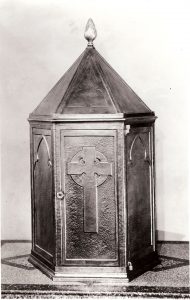Cyril Colnik: Liturgical Ironwork I
Cyril Colnik (1871-1958) was born in Triebein, Austria on September 20th, 1871. He traveled Europe as a journeyman, and later enrolled in to the Munich Indiustrial Art School. Germany adopted him, and sent him to help with their ironwork exhibit at the 1893 World’s Columbian Exhibition in Chicago. It is presumed he met Captain Frederick Pabst of Pabst Brewing fame at the fair. Not long afterward, Colnik came to Milwaukee to set up shop. Many believe it was by the influence of Captain Pabst.
I have collected a number of images of Colnik’s decorative and architectural ironwork over the years. In this post, I would like to present several of his liturgical works. Many of these images are from what I term as the
“orphan images”, as there is no indication as to whom these works belong.
The images below show Colnik’s fine command of repoussé. The repoussé process used was likely the “pitch” method, as described in an earlier post.
Repoussé was the process used for the side panels of the Gothic piece above.
The subject matter in the above repoussé rendering is obvious, as Christ carries his cross wearing the crown of thorns. He is on his walk to Calvary where he will be crucified. What is interesting is His erect posture. The other subjects, likely Jesus’ mother Mary, the other Mary Magdalene, are depicted as in extreme sorrow. Christ underwent severe torture before this event, and would hardly have been walking upright after such an ordeal. Yet He is upright, and reaching out tenderly to the weeping women, seemingly oblivious to His own pain and demise. Perhaps Colnik’s intent was to portray Christ’s eventual triumph over pain, death and ultimately the sin of mankind, by depicting Him in this upright manner. Christ rose from the dead after three days in the tomb.
This small gate has a nice balance of form. The two three-lobed motifs speak of the “Trilogy of God”; God the Father, God the Son, and God the Holy Spirit.
This appears to be an electrified version of an “Eternal Light“, or a sanctuary lamp. Eternal light is representational of God’s eternal and all encompassing glory. The sanctuary lamp is used in a Catholic chapel or church to let the faithful know that the Blessed Sacrament is present. (The latter information regarding the sanctuary lamp was submitted to me by blog reader Thomas Forrest….thank you.)
In a future post, I will explore more liturgical works by Colnik.
…….Dan Nauman
“It is not enough to reach for the brass ring. You must also enjoy the merry-go-round.”…….Julie Andrews, Actress and Singer.






No comment to “Cyril Colnik: Liturgical Ironwork I”
M Nicholas - October 2, 2009
I just found my way to your site through abana.org. Thanks for the work you are putting into this blog as it is educational and inspiring – especially this recent post about Cyril Colnik and his liturgical work. I’m looking forward to the next installment.
Thomas Forrest - July 15, 2010
Sir,
The Gothic piece may be a tabernacle. The image of Jesus appears to be one of the “Stations of the Cross.” That is a devotion where the faithful follow Jesus from the condemanation of Pilate to the burial. This may be either Station IV “Jesus Meets His Mother” or Station VIII “Jesus Meets the Daughters of Jerusalem.”
LTC Forrest